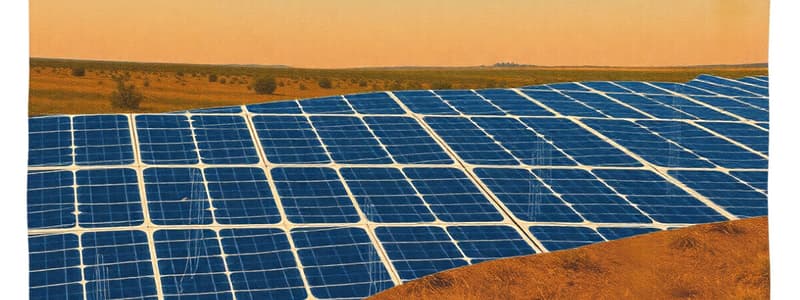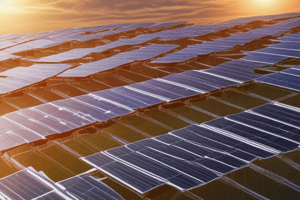Podcast
Questions and Answers
How does the reverse voltage influence the photocurrent in a photodiode?
How does the reverse voltage influence the photocurrent in a photodiode?
- It decreases the photocurrent significantly.
- It makes photocurrent behave non-linearly.
- It nearly has no influence on photocurrent. (correct)
- It has a strong positive correlation with photocurrent.
Which application would most likely require particularly sensitive photodetectors?
Which application would most likely require particularly sensitive photodetectors?
- Spectrometers.
- Night vision devices. (correct)
- Beam profilers.
- Optical data storage devices.
What is a potential downside of applying a higher reverse voltage to a photodiode?
What is a potential downside of applying a higher reverse voltage to a photodiode?
- It leads to increased heating of the device. (correct)
- It prevents the device from responding quickly.
- It reduces the effective area of the photodiode.
- It decreases the sensitivity of the device.
In what scenario is a fast photodetector especially important?
In what scenario is a fast photodetector especially important?
What is one of the main applications of two-dimensional arrays of photodetectors?
What is one of the main applications of two-dimensional arrays of photodetectors?
What type of device has largely replaced vacuum phototubes?
What type of device has largely replaced vacuum phototubes?
Which layer is typically present in a PIN photodiode?
Which layer is typically present in a PIN photodiode?
In photoconductive mode, what is primarily measured?
In photoconductive mode, what is primarily measured?
What is a disadvantage of using a large active area in a photodiode?
What is a disadvantage of using a large active area in a photodiode?
What is a characteristic of the photovoltaic mode of a photodiode?
What is a characteristic of the photovoltaic mode of a photodiode?
What effect do electron-hole pairs have in photodiodes?
What effect do electron-hole pairs have in photodiodes?
What factor can limit the efficiency of a photodiode?
What factor can limit the efficiency of a photodiode?
What does the anti-reflection coating on a photodiode do?
What does the anti-reflection coating on a photodiode do?
What is the primary function of a solar cell?
What is the primary function of a solar cell?
Which semiconductor configuration is primarily used in a solar cell?
Which semiconductor configuration is primarily used in a solar cell?
What is the maximum open-circuit voltage produced by a single junction silicon solar cell?
What is the maximum open-circuit voltage produced by a single junction silicon solar cell?
What triggers the conversion process in a solar cell when light photons reach the p-n junction?
What triggers the conversion process in a solar cell when light photons reach the p-n junction?
What is the role of the thinner p-type semiconductor layer in a solar cell?
What is the role of the thinner p-type semiconductor layer in a solar cell?
What happens to free electrons in the depletion region of a solar cell when light is absorbed?
What happens to free electrons in the depletion region of a solar cell when light is absorbed?
What does the barrier potential of the p-n junction prevent?
What does the barrier potential of the p-n junction prevent?
How are individual solar cells typically assembled for increased energy generation?
How are individual solar cells typically assembled for increased energy generation?
What is primarily generated in the depletion region of photodiodes when light is absorbed?
What is primarily generated in the depletion region of photodiodes when light is absorbed?
Which type of photodetector is characterized by potentially high speeds with bandwidths up to hundreds of GHz?
Which type of photodetector is characterized by potentially high speeds with bandwidths up to hundreds of GHz?
What advantage do phototransistors have over photodiodes?
What advantage do phototransistors have over photodiodes?
Which photodetector type is known for having a nonlinear response and slow performance?
Which photodetector type is known for having a nonlinear response and slow performance?
What is a notable characteristic of avalanche photodiodes?
What is a notable characteristic of avalanche photodiodes?
What distinguishes photomultipliers from standard phototubes?
What distinguishes photomultipliers from standard phototubes?
Which materials are being researched for novel photodetectors that offer fast responses?
Which materials are being researched for novel photodetectors that offer fast responses?
In what field do photodetectors play a crucial role?
In what field do photodetectors play a crucial role?
What is the efficiency of a solar cell defined as?
What is the efficiency of a solar cell defined as?
What does the fill factor (FF) of a solar cell represent?
What does the fill factor (FF) of a solar cell represent?
Which of the following materials is NOT commonly used in solar cells?
Which of the following materials is NOT commonly used in solar cells?
Which of the following is NOT a criterion for materials used in solar cells?
Which of the following is NOT a criterion for materials used in solar cells?
What contributes to the low efficiency of solar cells?
What contributes to the low efficiency of solar cells?
What is a disadvantage of solar cells?
What is a disadvantage of solar cells?
Which of the following factors does NOT affect the efficiency of a solar cell?
Which of the following factors does NOT affect the efficiency of a solar cell?
What happens at the open-circuit and short-circuit points of a solar cell?
What happens at the open-circuit and short-circuit points of a solar cell?
Flashcards
Solar Cell
Solar Cell
An electrical device that converts light energy into electrical energy via the photovoltaic effect.
Photovoltaic Effect
Photovoltaic Effect
The process where light energy is converted into electrical energy in specific semiconductor materials.
p-n junction diode
p-n junction diode
A key component within a solar cell, utilizing the properties of a p-type and n-type semiconductor.
Solar Panel
Solar Panel
Signup and view all the flashcards
Electron-hole pairs
Electron-hole pairs
Signup and view all the flashcards
Depletion Region
Depletion Region
Signup and view all the flashcards
Barrier Potential
Barrier Potential
Signup and view all the flashcards
Open-Circuit Voltage
Open-Circuit Voltage
Signup and view all the flashcards
Photo Voltage
Photo Voltage
Signup and view all the flashcards
I-V Characteristics
I-V Characteristics
Signup and view all the flashcards
Solar Cell Efficiency
Solar Cell Efficiency
Signup and view all the flashcards
Fill Factor
Fill Factor
Signup and view all the flashcards
Band Gap
Band Gap
Signup and view all the flashcards
Ideal Band Gap
Ideal Band Gap
Signup and view all the flashcards
Advantages of Solar Cells
Advantages of Solar Cells
Signup and view all the flashcards
Disadvantages of Solar Cells
Disadvantages of Solar Cells
Signup and view all the flashcards
What are solar cells used for?
What are solar cells used for?
Signup and view all the flashcards
What are photodetectors?
What are photodetectors?
Signup and view all the flashcards
Photodiode
Photodiode
Signup and view all the flashcards
What are MSM photodetectors?
What are MSM photodetectors?
Signup and view all the flashcards
Phototransistor
Phototransistor
Signup and view all the flashcards
Photoconductive detector
Photoconductive detector
Signup and view all the flashcards
Phototube
Phototube
Signup and view all the flashcards
Photomultiplier
Photomultiplier
Signup and view all the flashcards
Photodetector
Photodetector
Signup and view all the flashcards
PIN photodiode
PIN photodiode
Signup and view all the flashcards
Photocurrent
Photocurrent
Signup and view all the flashcards
Photovoltaic mode
Photovoltaic mode
Signup and view all the flashcards
Photoconductive mode
Photoconductive mode
Signup and view all the flashcards
Active area of photodiode
Active area of photodiode
Signup and view all the flashcards
Anti-reflection coating
Anti-reflection coating
Signup and view all the flashcards
Photocurrent vs Light Power
Photocurrent vs Light Power
Signup and view all the flashcards
Reverse Voltage Impact
Reverse Voltage Impact
Signup and view all the flashcards
Photodetector Applications
Photodetector Applications
Signup and view all the flashcards
Types of Photodetectors
Types of Photodetectors
Signup and view all the flashcards
Focal Plane Arrays
Focal Plane Arrays
Signup and view all the flashcards
Study Notes
Solar Cells
- Solar cells, also known as photovoltaic (PV) cells, convert light energy into electrical energy using the photovoltaic effect.
- Solar cells are p-n junction diodes, and their electrical characteristics (current, voltage, resistance) change when exposed to light.
- Individual solar cells are combined to form modules, commonly known as solar panels.
- A typical single-junction silicon solar cell produces a maximum open-circuit voltage of approximately 0.5 to 0.6 volts.
- Combining multiple cells into a large solar panel generates substantial amounts of renewable energy.
How Solar Cells Work
- Photons from sunlight strike the solar cell.
- The photons' energy creates free electrons that accumulate in the n-type silicon.
- An external circuit allows electrons to flow, generating an electrical current.
Photovoltaic Effect
- This effect converts light energy to electrical energy in certain semiconductor materials.
- The process directly converts light energy to electricity without any intermediate steps.
Solar Cell Construction
- Similar to a junction diode, but construction slightly differs.
- A thin layer of p-type semiconductor is grown on a thicker n-type semiconductor.
- Fine electrodes are applied to the p-type layer, and a p-n junction is created beneath it.
- A current-collecting electrode is placed on the bottom of the n-type layer.
- The entire assembly is encapsulated in glass to protect it from damage.
Working Principle of Solar Cells
- Incident light photons supply enough energy to create electron-hole pairs in the junction.
- This disrupts thermal equilibrium within the junction.
- Free electrons in the depletion region quickly move to the n-type side.
- Similarly, holes move to the p-type side.
- This electron-hole separation creates a photovoltage.
- An external circuit connected across the junction allows current flow.
I-V Characteristics of Solar Cells
- Graph showing the relationship between current and voltage output.
- "Short Circuit Current" (Isc) - maximum current when no load is applied.
- "Open Circuit Voltage" (Voc) - maximum voltage when no current flows.
- "Maximum Power Point" (MPP) - point where maximum power is generated (Vmp, Imp).
- "Fill Factor" (FF) - ratio of maximum power to the product of Voc and Isc. This quantifies how efficiently the solar cell converts light into usable energy.
Solar Cell Efficiency
- Efficiency is the ratio of energy output to energy input from the sun.
- Factors influencing efficiency include incident sunlight spectrum, intensity, and the solar cell's temperature.
Materials Used in Solar Cells
-
Materials must have a bandgap near 1.5 eV for optimal light absorption and electrical efficiency.
-
Common materials include Silicon, GaAs, CdTe, and CuInSe2.
-
Criteria for materials: suitable bandgap, high electrical conductivity, and readily available, low-cost raw materials.
Advantages of Solar Cells
- No air pollution.
- Long lifespan.
- Low maintenance costs.
Disadvantages of Solar Cells
- High installation costs.
- Low efficiency in cloudy conditions.
- No energy generation at night.
Applications of Solar Cells
- Powering small devices (calculators, watches).
- Large-scale applications (spacecraft, renewable energy systems).
Photodetectors
- Devices that detect light and generate an electronic output signal.
- Output signal is proportional to the incident light power.
Types of Photodetectors
- Photodiodes.
- Phototransistors.
- Photoconductive detectors.
- Phototubes/Photoemissive detectors.
- Photomultipliers.
Photodiode Construction
- Uses a p-n junction with an intrinsic layer (i). Sometimes called a p-i-n or PIN photodiode.
- Light absorbed in the depletion region generates electron-hole pairs.
- Output photocurrent is proportional to the light intensity.
Photovoltaic vs Photoconductive Modes of Operation
- Photovoltaic: Similar to a solar cell; creates a voltage from light across a load. Not typically as linear or wide-ranging as the photoconductive mode in terms of the power levels it can handle.
- Photoconductive: Applies a reverse bias to the diode and measures resulting current. Can have high responsiveness over a wide range of light power levels to be much more linear.
Applications of Photodetectors
- Radiometry/photometry applications.
- Optical power measurements.
- Various optical sensors, such as light barriers.
- Fiber optics communications.
- Laser rangefinders and metrology.
- Image sensors (cameras).
Studying That Suits You
Use AI to generate personalized quizzes and flashcards to suit your learning preferences.




